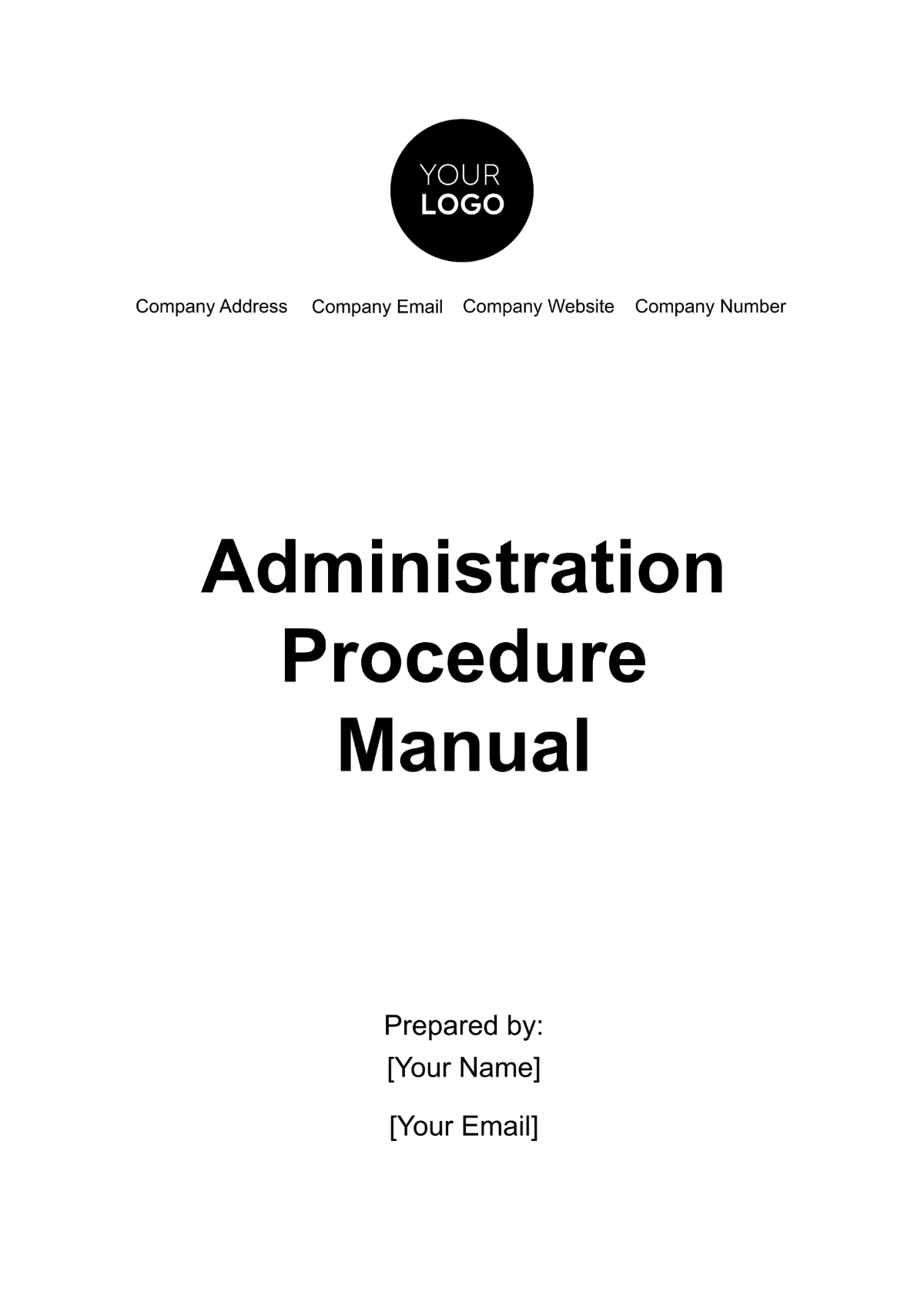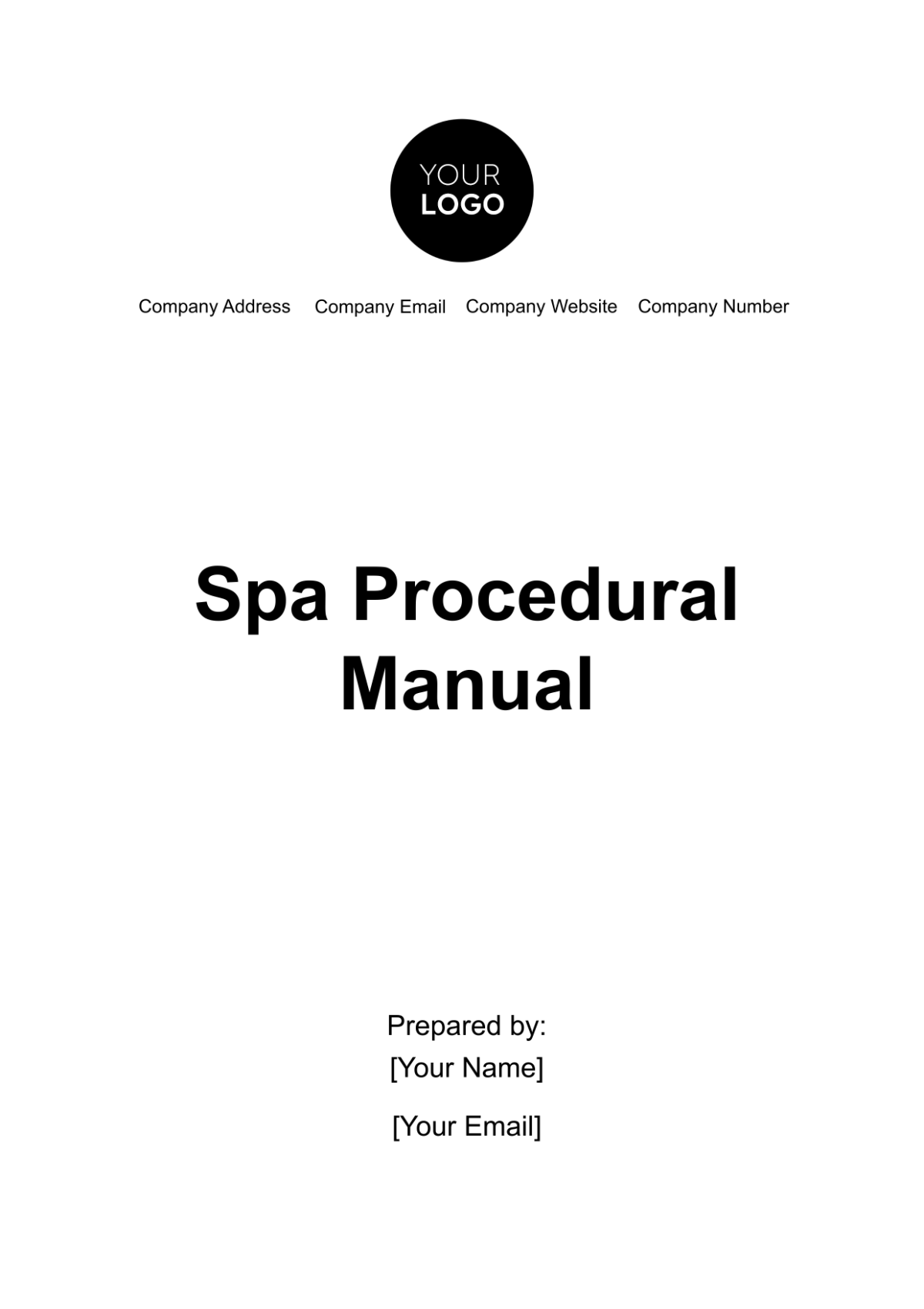Warehouse Procedure Manual
Name: | Company: | Department: | Date: |
|---|---|---|---|
[YOUR NAME] | [YOUR COMPANY NAME] | [YOUR DEPARTMENT] | [CURRENT DATE] |
I. Introduction
The [YOUR COMPANY NAME] Warehouse Procedure Manual serves as a comprehensive guide for all employees involved in warehouse operations. This manual outlines the standard procedures, safety protocols, and best practices to ensure efficient and safe functioning of the warehouse facility. By adhering to the guidelines outlined in this manual, [YOUR COMPANY NAME] aims to optimize warehouse processes, minimize errors, and maintain a conducive working environment.
A. Purpose
The purpose of this manual is to:
Provide clear instructions and guidelines for performing various tasks within the warehouse.
Ensure compliance with safety regulations and company policies.
Standardize workflows to improve efficiency and productivity.
Serve as a reference tool for training new employees and refreshing existing employees on warehouse procedures.
B. Scope
This manual covers a wide range of topics related to warehouse operations, including but not limited to:
Receiving and storing goods
Inventory management
Order fulfillment
Equipment usage and maintenance
Safety procedures
Quality control measures
II. Personnel Training and Responsibilities
The success of [YOUR COMPANY NAME] warehouse operations relies heavily on well-trained personnel who understand their roles and responsibilities. It is essential for all employees to undergo thorough training and regularly refresh their knowledge on warehouse procedures.
A. Training Programs
[YOUR COMPANY NAME] provides comprehensive training programs for all warehouse personnel. These programs cover topics such as:
Safety protocols and procedures
Equipment operation and maintenance
Inventory management systems
Order processing and fulfillment
Emergency response protocols
B. Responsibilities
Each employee within the warehouse has specific responsibilities to ensure smooth operations. These responsibilities include:
Maintaining cleanliness and organization within designated work areas.
Following established procedures for receiving, storing, and picking goods.
Reporting any safety hazards or equipment malfunctions to the appropriate personnel.
Participating in regular training sessions to stay updated on warehouse procedures and safety protocols.
III. Warehouse Operations
Warehouse operations encompass a variety of tasks and processes aimed at efficiently managing inventory and fulfilling customer orders. It is crucial for all employees to understand and adhere to the standard operating procedures outlined in this section to ensure the smooth functioning of the warehouse.
A. Receiving Goods
Receiving goods accurately and efficiently is essential for maintaining inventory integrity. Upon receipt of goods, employees must follow these procedures:
Inspection: Inspect incoming shipments for damage or discrepancies and document any issues.
Verification: Verify received quantities against purchase orders or packing slips.
Labeling: Properly label and tag received goods for easy identification and storage.
B. Storing Goods
Proper storage of goods is vital to optimize warehouse space and facilitate easy retrieval. Follow these guidelines for storing goods:
Organization: Group similar items together and use appropriate storage bins or racks.
Accessibility: Ensure that frequently picked items are easily accessible, while less frequently picked items are stored in less accessible areas.
Safety: Adhere to weight limits and stacking guidelines to prevent accidents and damage to goods.
C. Order Fulfillment
Efficient order fulfillment is critical for meeting customer demands and maintaining customer satisfaction. The order fulfillment process involves:
Order Processing: Receive and process customer orders accurately and promptly.
Picking: Locate and pick items from designated storage locations according to the order requirements.
Packing: Safely pack items for shipment, ensuring they are secure and protected from damage during transit.
Shipping: Coordinate with shipping carriers to ensure timely delivery of orders to customers.
IV. Equipment Usage and Maintenance
Proper usage and maintenance of warehouse equipment are essential for ensuring employee safety and prolonging the lifespan of equipment. Employees must adhere to the following guidelines when using warehouse equipment:
A. Forklift Operation
Forklifts are commonly used in warehouse operations for lifting and transporting heavy loads. To operate a forklift safely, employees must:
Receive Training: Complete a forklift training program and obtain certification before operating a forklift.
Inspect Equipment: Conduct pre-use inspections to ensure the forklift is in proper working condition.
Follow Safety Protocols: Adhere to speed limits, maintain a safe distance from other objects and pedestrians, and use caution when operating on inclines or uneven surfaces.
B. Pallet Jack Usage
Pallet jacks are used for moving palletized goods within the warehouse. When using a pallet jack, employees should:
Inspect Equipment: Check the condition of the pallet jack before each use, paying attention to the wheels, handle, and hydraulic system.
Secure Loads: Ensure that loads are properly balanced and secured to the pallet before moving them with a pallet jack.
Operate Safely: Use caution when maneuvering the pallet jack to avoid collisions with obstacles or other personnel in the warehouse.
C. Conveyor Systems
Conveyor systems are used to automate the movement of goods within the warehouse. To operate conveyor systems safely:
Keep Clearances: Maintain proper clearances around conveyor belts to prevent entanglement or pinch points.
Monitor Operations: Regularly inspect conveyor belts for signs of wear or damage and address any issues promptly.
Follow Lockout/Tagout Procedures: Before performing maintenance or repair work on conveyor systems, follow lockout/tagout procedures to ensure the equipment is safely de-energized.
V. Safety Procedures
Ensuring the safety of all personnel is a top priority in warehouse operations. [YOUR COMPANY NAME] is committed to providing a safe working environment and requires all employees to adhere to the following safety procedures:
A. Personal Protective Equipment (PPE)
Employees must wear appropriate PPE, including safety helmets, gloves, steel-toed boots, and high-visibility vests, as required by their job duties.
B. Emergency Response
In the event of an emergency, such as a fire or chemical spill, employees should:
Evacuate: Follow evacuation procedures and proceed to the designated assembly area.
Notify Authorities: Contact emergency services and alert warehouse management of the situation.
Assist Others: Assist coworkers and visitors in evacuating the premises safely.
C. Hazard Communication
Employees should be aware of potential hazards in the workplace and understand how to safely handle hazardous materials. Hazard communication procedures include:
Labeling: Properly label containers containing hazardous materials with appropriate warning labels.
Material Safety Data Sheets (MSDS): Maintain MSDS for all hazardous substances used in the warehouse and make them readily accessible to employees.
VI. Inventory Management
Effective inventory management is crucial for optimizing warehouse space, minimizing stockouts, and ensuring timely order fulfillment. [YOUR COMPANY NAME] employs the following procedures to maintain accurate inventory records and streamline inventory management processes:
A. Cycle Counting
Cycle counting involves regularly counting a portion of inventory items to ensure accuracy without disrupting daily operations. The cycle counting process includes:
Identification: Select a subset of inventory items to be counted during each cycle counting session.
Counting: Physically count the selected items and compare the counts to the inventory records.
Discrepancy Resolution: Investigate any discrepancies between the physical count and inventory records to identify root causes and implement corrective actions.
B. Inventory Replenishment
To prevent stockouts and ensure optimal inventory levels, [YOUR COMPANY NAME] utilizes inventory replenishment procedures, including:
Reorder Point: Establish reorder points for each inventory item based on historical demand and lead times.
Order Quantity: Determine the optimal order quantity to balance inventory carrying costs and the risk of stockouts.
Supplier Management: Maintain relationships with reliable suppliers and monitor supplier performance to ensure timely delivery of replenishment orders.
VII. Quality Control
Maintaining high-quality standards for goods stored in the warehouse is essential for customer satisfaction and retention. [YOUR COMPANY NAME] implements the following quality control measures to ensure that only products meeting quality standards are shipped to customers:
A. Inspection Procedures
Before goods are accepted into inventory or shipped to customers, they undergo thorough inspection procedures to identify any defects or discrepancies. Inspection procedures include:
Visual Inspection: Examine goods for visible defects such as damage, discoloration, or irregularities in packaging.
Functional Testing: Test functional components of products to ensure they meet performance specifications.
Documentation Review: Verify that all required documentation, such as certificates of conformity or quality inspection reports, accompanies the goods.
B. Non-Conformance Management
In the event that goods do not meet quality standards, [YOUR COMPANY NAME] has established procedures for managing non-conformances, including:
Identification: Document and report non-conforming products through established channels.
Disposition: Determine the appropriate disposition of non-conforming products, which may include rework, return to supplier, or disposal.
Root Cause Analysis: Conduct root cause analysis to identify the underlying reasons for non-conformances and implement corrective actions to prevent recurrence.
VIII. Environmental Management
Environmental management practices are implemented to minimize the environmental impact of warehouse operations and promote sustainability. [YOUR COMPANY NAME] is committed to reducing its carbon footprint and conserving natural resources through the following environmental management initiatives:
A. Waste Management
Efficient waste management practices are essential for minimizing waste generation and promoting recycling and reuse. [YOUR COMPANY NAME] follows these waste management procedures:
Segregation: Segregate waste streams to facilitate recycling and proper disposal of hazardous materials.
Recycling Programs: Implement recycling programs for materials such as cardboard, paper, plastic, and metal.
Waste Reduction: Identify opportunities to reduce waste generation through process optimization and material substitution.
B. Energy Efficiency
Reducing energy consumption is a key focus area for [YOUR COMPANY NAME] to minimize greenhouse gas emissions and lower operational costs. Energy efficiency measures include:
Lighting Upgrades: Replace traditional lighting fixtures with energy-efficient LED lights.
Equipment Optimization: Implement energy-saving settings on warehouse equipment and machinery.
Building Automation: Install building automation systems to optimize heating, ventilation, and air conditioning (HVAC) systems.
IX. Health and Wellness
Ensuring the health and wellness of warehouse personnel is a priority for [YOUR COMPANY NAME]. Healthy employees are more productive and engaged, leading to improved warehouse performance. The following initiatives promote health and wellness within the workplace:
A. Ergonomic Practices
Implementing ergonomic practices helps prevent workplace injuries and promotes employee well-being. [YOUR COMPANY NAME] follows these ergonomic guidelines:
Proper Lifting Techniques: Train employees on proper lifting techniques to minimize the risk of back injuries.
Adjustable Workstations: Provide adjustable workstations and seating to accommodate employees of different heights and body types.
Regular Breaks: Encourage employees to take regular breaks to stretch and rest, reducing the risk of repetitive strain injuries.
B. Wellness Programs
[YOUR COMPANY NAME] offers wellness programs to support employee health and well-being. These programs may include:
Fitness Challenges: Organize fitness challenges or competitions to encourage physical activity among employees.
Nutrition Education: Provide resources and workshops on healthy eating habits and nutrition.
Mental Health Support: Offer resources and counseling services to support employee mental health and well-being.
X. Conclusion
The [YOUR COMPANY NAME] Warehouse Procedure Manual serves as a comprehensive resource for all employees involved in warehouse operations. By adhering to the guidelines and procedures outlined in this manual, employees can contribute to the efficient and safe functioning of the warehouse facility. [YOUR COMPANY NAME] is committed to continuously improving warehouse operations and promoting a culture of safety, quality, and environmental responsibility.
A. Feedback and Suggestions [YOUR COMPANY NAME] welcomes feedback and suggestions for improving this manual and warehouse operations. Employees are encouraged to provide input on ways to enhance processes, streamline workflows, and promote a positive work environment.
B. Acknowledgments [YOUR COMPANY NAME] acknowledges the contributions of all employees who participated in the development and review of this Warehouse Procedure Manual. Their expertise and dedication have been instrumental in creating a valuable resource for the entire warehouse team.

















































